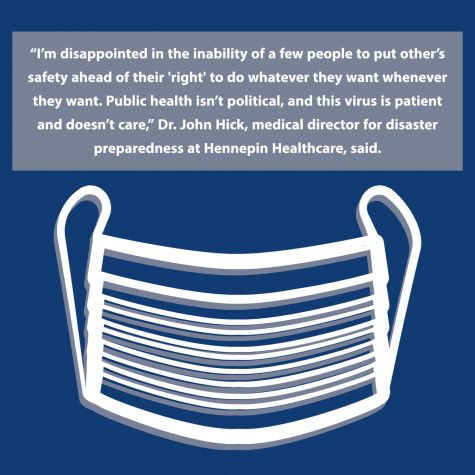
May 17, 2020 – RubicOnline
May 18, 2020 – Best of SNO
Minnesota’s current Stay at Home order expires May 17, then enters a “Stay Safe MN” strategy. The state recommends elderly people and people with underlying medical conditions to continue staying home due to statistics showing COVID-19 affects them more. Social distancing recommendations still apply to everyone. As of May 18, retail can open with restrictions including 50% capacity, and small group gatherings of 10 people or less are allowed. Barbershops, salons, bars, restaurants, gyms, and theaters are allowed to open June 1, with specific restrictions that on May 20, state officials will release. While the state recommends masks, many businesses are taking a step further and requiring them.
John Hick, medical director for disaster preparedness at Hennepin Healthcare, said, “Covid is sneaky because you can feel totally fine and be spreading the virus really aggressively. It’s like walking around stabbing people, many will be injured, and a few will die.”
As a worker in the healthcare system who’s advising the state in their decisions, Hick said, “We need to decrease the number of people that one sick person infects. Because this is exponential growth, when out of control, it would totally overwhelm the healthcare system. If we try to slow transmission with masks and distancing, we can keep the patient numbers manageable. And every day brings better understanding of the disease and how it attacks the body.” By “exponential growth,” he’s referring to the spread rate of COVID-19 becoming more rapid as the total number of cases rises. Hick said, “The fewer people we’re around, the better. During the Stay at Home, if you’re not reducing contacts by over 90%, then it doesn’t work.”
“Stay Safe MN” encourages outdoor activities more than the Stay at Home order did. The health benefits of sunlight and exercise offer preparation for your body if your immune system has to fight against COVID-19. Hick said, “Sunshine and fresh air help to reduce anxiety and can even boost the immune system with additional Vitamin D.”

There is also evidence that COVID-19 can not spread or survive outside as sufficiently as inside. Hick said, “The virus spreads by contact and survives on indoor surfaces much better than outdoors. Wind disperses the virus in ways that don’t happen indoors. Also, sunlight inactivates the virus much faster than it inactivates indoors. Indoors, you don’t have as much volume of air for the virus to disperse, or be diluted, in, so you’re more likely to inhale the particles.”
Even outside, distancing, and sometimes masks are incredibly crucial in limiting the spread. If you’re able to stay farther than six feet from others, you most likely don’t need to wear a mask. Masks can offer some protection to the wearer from contracting the virus but offer considerably more security to the surrounding people from getting sick from the wearer. Activities such as running and biking generate air disturbances that medical experts have not been able to accurately quantify in a way that they can use to make recommendations to the public. Hick recommends to increase the distance you stay away from others based on how much air movement the activity creates. Articles from National Public Radio and The New York Times recommend runners to distance between 10 and 15 feet from others.
The public has had mixed responses to mask recommendations. Hick said, “I’m disappointed in the inability of a few people to put other’s safety ahead of their ‘right’ to do whatever they want whenever they want. Public health isn’t political, and this virus is patient and doesn’t care.”
The characterizing factors of COVID-19 are the unknowns. Antibody testing is acting as a public health test. Experts don’t know what it means yet; they don’t know if you’re immune, or if the antibodies are a reaction to a different coronavirus before COVID-19. Nasal and oral diagnostic tests are relatively accurate.
Hick said, “Better [nasal and oral tests] and better availability, will help us find more cases, and then quickly isolate them. It’s the only thing aside from strict social distancing that’s worked. That said, a vocal segment of Americans objects to contact tracing, so we may have trouble finding those other cases well.” The main goals of contact tracing are to notify people that have been exposed to the virus by monitoring infected people and supporting the exposed people through quarantine to ensure the effectiveness of their quarantine.
One thing that experts know about COVID-19 is that it will change society. Hick said, “I think we’ll see more masks from this for years. I believe we’ll finally get a handle on better protection for healthcare workers that are years overdue. We might figure out better vaccine technology and some new medical therapies. […] It’s going to kill for probably years, and we’ll see more peaks of infection over the next year or two. Probably lesser peaks over time, but nobody knows. We’ll probably also have to go back to more strict social distancing when it worsens and relax the restrictions carefully as we keep learning.”